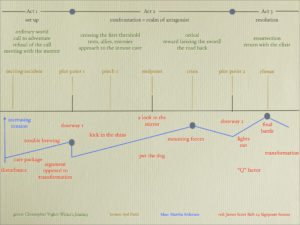As promised in my last blog post, in this one I’m going to address the multiple ways you can look at plot, and how simplifying your approach may in fact help.
The Plot Paradigm
The earliest plot paradigm harks all the way back to Aristotle, who defined the three-act structure in his Poetics, as this: each story has a beginning, middle, and end. Since that time a number of authors have adapted this simple structure into a variety of more detailed formulae. I put together the following chart a while back in order to see all of my favorite plot paradigms in one place:
If you search the web you can find all sorts of other plots structures – some good, some wickedly complex – that purport to help a writer discover their plot. Some will take you scene-by-scene through a novel. Some hark to a screenplay structure. Some will help you with rising tension, some with the tentpole-middle moment, some through a hero’s journey, some by envisioning a snowflake, some pay attention to the middle muddle.
Just to help you feel better if you are struggling with plot, my friend the author Caroline Starr Rose recently posted about her own insecurities and attempts to find the “right” way to plot. And she’s written three compelling novels, so something must be working.
Here’s the bottom line: you need to find the paradigm that suits you. That suits your brain. The way you think and work.
Simplifying The Process
Having said that, I do believe that there are a couple of things you can do to find that perfect structure that fits your personality and writing style without losing your mind trying every single one.
First, I submit that all stories are really about one thing: a character with a desire. The arc of a story is determined by following the character’s desire to fruition – to her goal. The best stories place multiple obstacles (including an antagonist) in the path of the character so that she can learn and grow as she overcomes them to reach her goal.
Here’s what I do now, before I begin my “plantsing” routine:
- Determine my character’s desire and goal.
- Determine what obstacles (in general) will be placed between the character and her goal.
- Determine how/whether she will reach her goal (happy versus sad ending).
Any one of these plot paths/outlines/strategies would accomplish the same outcome for the above three simple determinations. I’ve used each of these plot plans at least once, and some more. Now I think a simpler structure works for me. I gauge scenes the way I envision the entire novel – with rising and falling action. This is the “plotter” part of my work.
The key is that I have a trajectory – a desire line, with a desired outcome – and that allows me then to “pants”, or be an organic writer, as I like to do.
At The Scene Level
Now, there is one complication to such simplicity. At the scene level, the character must not only encounter obstacles in the face of rising and falling action – the character must have a reason to be in the scene, and there must be an outcome to the character’s actions. This “cause-and-effect” trajectory is what propels a story forward and why so many of these more complicated models are appealing, as they often address this second-level, scene-level, tension-building trajectory. So, if you need help finding that second-level arc, check out the various possibilities.
I think your instincts will guide you to the best fit for you.
One other caveat – I’ve discovered that my needs and issues have morphed over time and that each novel presents a new and unique challenge. In other words, there is no one right way to write.
In a future post I’m going to talk more about character, as I sincerely believe that all stories – all – are inherently character-driven.
How To Find Your Plot Model
Here are some (and only some!) of the models and craft books that will lead you to your “best fit” to see plot:
Martha Alderson: The Plot Whisperer Workbook
James Scott Bell: (anything of his but especially) Write Your Novel From the Middle
Lisa Cron: Story Genius
Christopher Vogler: The Writer’s Journey
Syd Field: (anything again but especially) The Screenwriter’s Workshop
Blake Snyder: Save The Cat
Robert McKee: Story
Donald Maass: Writing The Breakout Novel Workbook


Yay! I have most of those books! All great resources! Thanks for compiling this list!
Oh, good! Yes, these are my favorites. You can never have enough craft books…:)
Well, what a treat to find my name here! I love your comprehensive diagram! Have you ever heard of orphan – wanderer – warrior – martyr? I’m not sure who came up with it, but it’s a helpful, concise way to view the character arc through the three acts (wanderer and warrior come in act ii).
I loved that post of yours. I haven’t heard of that sequence and it’s very interesting. I’ll be looking more deeply at character next!